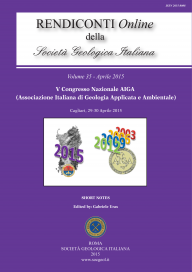
Yet another disaster flood of the Bisagno stream in Genoa (Liguria, Italy): October the 9th -10th 2014 event
Francesco Faccini (a), Fabio Luino (b), Guido Paliaga (c), Alessandro Sacchini (c) & Laura Turconi (b)
(a) Department of Earth, Environmental and Life Sciences, University of Genoa, Corso Europa, 26, 16132 Genoa, Italy. E-mail: faccini@unige.it
(b) National Research Council, Research Institute for Geo-hydrological Protection, Strada delle Cacce, 73, 10135 Turin, Italy. E-mail: Fabio.luino@irpi.cnr.it
(c) Geologist consultant (Ph.D.), Genoa, Italy. E-mail: gpaliaga@gmail.com; alesac67@gmail.com
Volume: 35/2015
Pages: 128-131
Abstract
On 2014, 9th October, short and heavy rainfall hit the Bisagno Valley. The Bisagno stream overflowed again and flooded the center of Genoa, causing severe economic damage and a victim. This is the fourth serious flooding of the stream in the last fifty years, which shows similarities with the previous catastrophic ones in 1970, 1992 and 2011, both because of the trigger conditions, determined by the orography of the city of Genoa, and for the weather situations marked by an anticyclonic block converging over the Liguria Gulf.
Between 06:00 a.m. on October the 9th and 12:00 a.m. on October the 10th in the Bisagno catchment were recorded some peaks of rain up to almost 140 mm/h and heaps of more than 550 mm/24hrs, which resulted in a rapid increase in the level of all streams of the Bisagno basin and subsequent flooding in the final stretch of the Bisagno stream, where the watercourse underflows covered by a long manhole for the last 1.4 kilometres.
Interventions for risk mitigation through more careful weather-hydrology monitoring in "nowcasting", the improvement of the civil protection activities, structural works on the watercourse, maintenance of the territory of the Bisagno catchment, a correct information and a timely communication to the population living in high risk areas are all urgently needed.
Keywords
Get Full Text